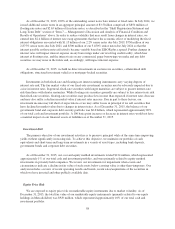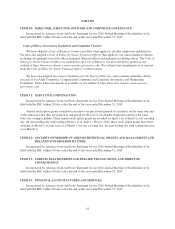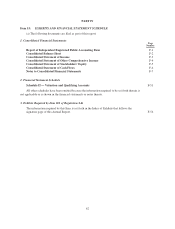eBay 2015 Annual Report Download - page 71
Download and view the complete annual report
Please find page 71 of the 2015 eBay annual report below. You can navigate through the pages in the report by either clicking on the pages listed below, or by using the keyword search tool below to find specific information within the annual report.Foreign Currency Risk
Our commerce platforms operate globally, resulting in certain revenues and costs that are denominated in
foreign currencies, primarily the Euro, British pound, Korean won and Australian dollar, subjecting us to foreign
currency risk which may adversely impact our financial results. We transact business in various foreign
currencies and have significant international revenues as well as costs. In addition, we charge our international
subsidiaries for their use of intellectual property and technology and for certain corporate services we provide.
Our cash flow, results of operations and certain of our intercompany balances that are exposed to foreign
exchange rate fluctuations may differ materially from expectations and we may record significant gains or losses
due to foreign currency fluctuations and related hedging activities.
We have a foreign exchange exposure management program designed to identify material foreign currency
exposures, manage these exposures and reduce the potential effects of currency fluctuations on our reported
consolidated cash flows and results of operations through the purchase of foreign currency exchange contracts.
The effectiveness of the program and the resulting usage of foreign exchange derivative contracts is at times
limited by our ability to achieve cash flow hedge accounting. These foreign currency exchange contracts are
accounted for as derivative instruments; for additional details related to our derivative instruments, please see
“Note 9 — Derivative Instruments” to our consolidated financial statements included in this report.
We use foreign exchange derivative contracts and invest non-U.S. cash in U.S. denominated investments to
ultimately protect our forecasted U.S. dollar-equivalent earnings from adverse changes in foreign currency
exchange rates. These hedging contracts reduce, but do not entirely eliminate, the impact of adverse currency
exchange rate movements. Most of these contracts are designated as cash flow hedges for accounting purposes.
For qualifying cash flow hedges, the effective portion of the derivative’s gain or loss is initially reported as a
component of accumulated other comprehensive income (AOCI) and subsequently reclassified into earnings in
the same period the forecasted transaction affects earnings. The ineffective portion of the unrealized gains and
losses on these contracts, if any, is recorded immediately in earnings. For contracts not designated as cash flow
hedges for accounting purposes, the derivative’s gain or loss is recognized immediately in interest and other, net,
in our consolidated statement of income. However, only certain revenue and costs are eligible for cash flow
hedge accounting. Subsequent to the Distribution, fewer of our currency flows meet the U.S. GAAP criteria for
cash flow hedge accounting. While, economically, we face the same currency risks, our statement of income is
more subject to volatility due to currency fluctuations.
We considered the historical trends in currency exchange rates and determined that it was reasonably
possible that changes in exchange rates of 20% for all currencies could be experienced in the near term. If the
relevant functional currencies weakened by 20% at December 31, 2015, the amount recorded in AOCI related to
our foreign exchange derivative contracts qualifying as cash flow hedges, before tax effect, would have been
approximately $45 million higher. If the relevant functional currencies strengthened by 20% at December 31,
2015, the amount recorded in AOCI related to our foreign exchange derivative contracts qualifying as cash flow
hedges, before tax effect, would have been approximately $27 million lower.
In addition, we use foreign exchange contracts to offset the foreign exchange risk on our assets and
liabilities denominated in currencies other than the functional currency of our subsidiaries. These contracts
reduce, but do not entirely eliminate, the impact of currency exchange rate movements on our assets and
liabilities. The foreign currency gains and losses on the assets and liabilities are recorded in interest and other,
net, which are offset by the gains and losses on the foreign exchange contracts.
We considered the historical trends in currency exchange rates and determined that it was reasonably
possible that adverse changes in exchange rates of 20% for all currencies could be experienced in the near term.
These changes would have resulted in an adverse impact on income before income taxes of approximately $27
million at December 31, 2015 taking into consideration the offsetting effect of foreign exchange forwards in
place as of December 31, 2015.
59
























